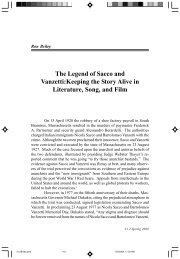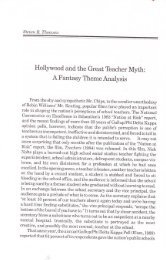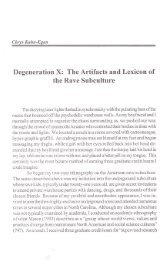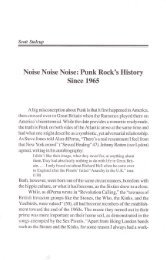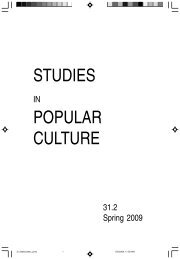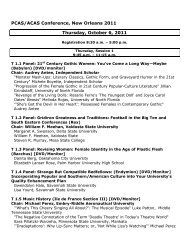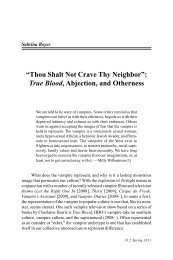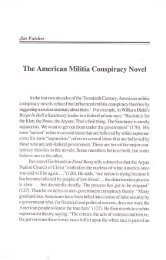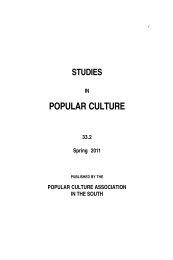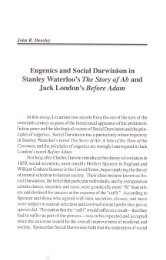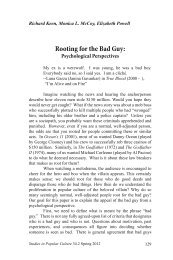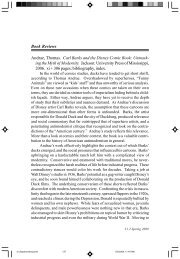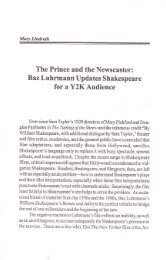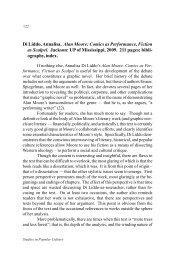'Sigmund Freud, Analyze This': How Madonna Situates - Popular ...
'Sigmund Freud, Analyze This': How Madonna Situates - Popular ...
'Sigmund Freud, Analyze This': How Madonna Situates - Popular ...
You also want an ePaper? Increase the reach of your titles
YUMPU automatically turns print PDFs into web optimized ePapers that Google loves.
86 David Sigler<br />
tack as evidence of a compulsion to repeat the scene of a trauma “which<br />
overrides the pleasure principle” (22).<br />
<strong>Freud</strong> and <strong>Madonna</strong> each work through fencing metaphors to illustrate<br />
the pathos of repetition, and each tells this tale through a seemingly<br />
supernatural series of displaced injuries and a duel with someone uncannily<br />
too much at home. Certainly the film’s extensive use of fencing themes<br />
and imagery, which provide the pretext for <strong>Madonna</strong>’s own cameo role in<br />
the film, suggests fencing as an especially appropriate vehicle for <strong>Madonna</strong>’s<br />
music video as well. But the video stages its fencing scene in a very<br />
different—indeed, specifically <strong>Freud</strong>ian—way. I want to understand this<br />
element of the music video, then, as an illustration (however possibly unintentional)<br />
of repetition’s role in the transference. In describing repetition<br />
compulsion as the symptom of trauma, <strong>Freud</strong> justifies the need for a “beyond”<br />
of the pleasure principle: “The compulsion to repeat also recalls<br />
from past experiences which include no possibility of pleasure” (SE XVIII:<br />
20). <strong>Madonna</strong>, consciously or not, illustrates the compulsion to repeat<br />
rather adequately: in the course of a four-minute song, she resolves to<br />
“die another day” no fewer than twenty-five times. For <strong>Freud</strong>, the compulsion<br />
to repeat actions or phrases is a sign of the “transference neurosis,”<br />
a problem that sometimes emerges within psychoanalysis and can<br />
further complicate cases of trauma (SE XVIII: 18).<br />
In introducing the topic of the transference neurosis, <strong>Freud</strong> describes<br />
a scene not at the traumatic warfront, nor in dreams: instead, he invites us<br />
into his office (SE XVIII: 18). Inhabiting this neurosis, <strong>Madonna</strong> places<br />
herself in a similar situation, taking on the role of the neurotic analysand,<br />
offering a defiant laugh and whispering “I need to lay down” into the microphone<br />
two-thirds of the way through the song. Addressed thus, <strong>Freud</strong>—<br />
and indeed the listener, who, in hearing this confession, is temporarily<br />
allied with <strong>Freud</strong>—becomes a master or father (thanks to the transference)<br />
able to authorize and supervise <strong>Madonna</strong>’s “laying.” <strong>Madonna</strong>’s<br />
utterance, at once sexually inviting and vaguely menacing, suggests that<br />
she has adopted an hysterical stance in relation to <strong>Freud</strong>. In <strong>Freud</strong>ian-<br />
Lacanian thought, the hysteric is by definition coquettish, playful, subver-<br />
Studies in <strong>Popular</strong> Culture



